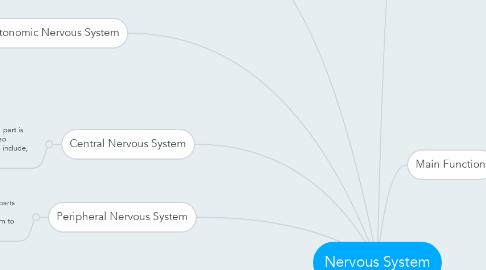
1. Central Nervous System
1.1. The brain and spinal cord form the Central Nervous system. This part is used to for processing, memory, and regulation systems. It is also responsible for the higher functions of the nervous system which include, language, creativity, expression, emotions, and personality.
2. Peripheral Nervous System
2.1. It includes all the parts outside of the brain and spinal cord. These parts include all of the cranial and spinal nerves, ganglia, and sensory receptors. The main function is to connect the central nervous system to the limbs and organs.
3. Somatic Nervous System
3.1. It is a division within the peripheral nervous system that includes all of the voluntary efferent neurons. It is the only consciously controlled part of the peripheral nervous system and is responsible for stimulating skeletal muscles in the body.
4. Autonomic Nervous System
4.1. It is also a division within the peripheral nervous system and it includes all of the involuntary efferent neurons. It controls subconscious effectors such as visceral muscle tissue, cardia muscle tissue and glandular tissue.
4.1.1. Sympathetic: It is a division within the autonomic nervous system that performs the response to stress, danger, excitement, exercise, emotions, and embarrassment. This division increases respiration and heart rate, releases adrenaline and other stress hormones.
4.1.2. Parasympathetic: This division performs the body's response to when the body is relaxed, resting or feeding. This is a way to undo the work the sympathetic division performed. It also works to decrease respiration and heart rate, increase digestion and permit the elimination of wastes.
5. Enteric Nervous System
5.1. It is a division within the autonomic nervous system that regulates digestion and the function of the digestive organs. The enteric nervous system receives signals from the central nervous system by both sympathetic and parasympathetic divisions.
6. Changes In Body Function
6.1. The nervous system monitors and coordinates internal organ function and responds to changes in the external environment.
6.2. It senses both changes within the body and outside of the body, this is the sensory function.
7. Main Function
7.1. It is used to send signals from one cell to another or from one part of the body to others.
7.1.1. Ways to do this is one is by releasing chemicals called hormones into the internal circulation, which would make it able to diffuse to distant sites.
7.1.2. Another way is the nervous system provides “point to point” signals; the cells target areas and makes connections with specific target cells.
8. Organs and Tissues
8.1. Brain
8.1.1. Centre of the nervous system, it controls body decision and the communication centre.
8.2. Cerebrum
8.2.1. Largest part of the brain, controls thought and action. Divided into four sections, frontal lobe, parietal lobe, occipital lobe, and temporal lobe.
8.3. Cerebellum
8.3.1. This is similar to the cerebrum, it is associated with regulation and co-ordination of movement, posture, and balance.
8.4. Nervous Tissue
8.4.1. It is made up of two classes, neurons and neuroglia. It is specialised to react to stimuli and to conduct impulses to various organs in the body which bring a response out.
8.5. Spinal Cord
8.5.1. It is a long, thin mass of bundled neurons that carry information.
8.6. Brain Stem
8.6.1. It is used for basic vital functions such as breathing, heartbeat, and blood pressure.
